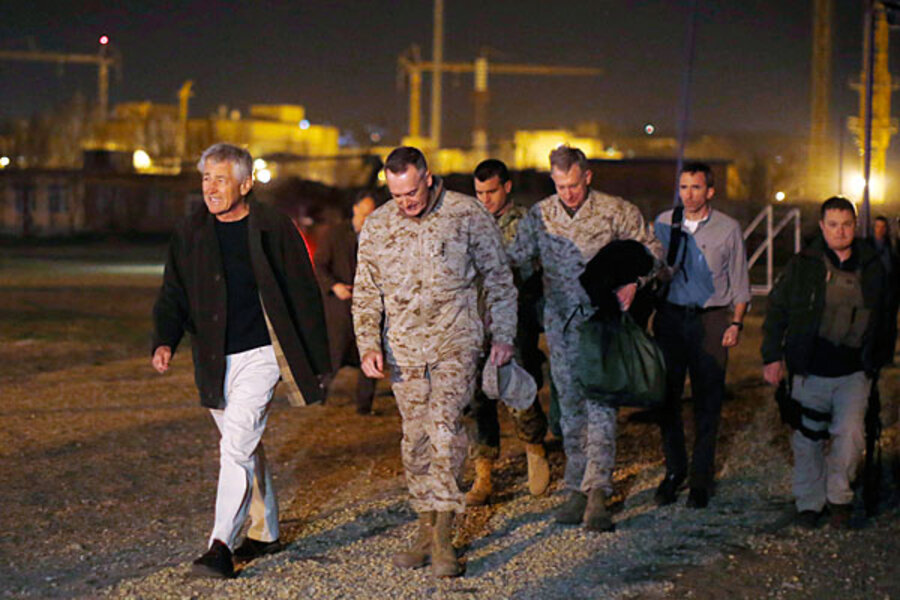In Afghanistan, Hagel faces early test: how many troops to leave behind
Loading...
| Washington
Chuck Hagel touched down in Kabul on Friday, his fifth visit to the country but his first as the brand new US secretary of Defense.
With a lengthy, even bruising, confirmation process just concluded in Washington, Secretary Hagel faces some considerable challenges that await him in Afghanistan, as US and NATO troops continue to fight a nearly 12-year-long war.
Among the most daunting of these is developing a plan for withdrawing US combat forces from the country by 2014. This means wrestling with two thorny questions: How quickly should American troops be withdrawn from Afghanistan – there are currently 66,000 in the country – and what is the ideal size for the residual force that will hold down the fort and continue training Afghan security forces after 2014?
This latter issue was brought into sharp focus this week during a Senate Armed Services Committee hearing with Gen. James Mattis, the outgoing head of US Central Command – the military command responsible for running the war in Afghanistan.
When Gen. Mattis told lawmakers that the size of the post-2014 US troop level was still under consideration, but that he had made his own recommendation to the president, Sen. John McCain (R) of Arizona, asked precisely what that recommendation was.
Mattis responded that he would like to see 13,600 US troops stay in Afghanistan after 2014.
This response caused a stir on Capitol Hill and within the halls of the Pentagon, because it is more than the roughly 8,000 to 12,000 that has reportedly been under consideration by the White House.
He noted that the NATO contribution would likely amount to roughly half of whatever the United States contributes.
Gen. John Allen, the head of US forces in Afghanistan, recently submitted his own proposal for US troop levels in the country to the White House for review and for President Obama’s ultimate decision.
A large portion of US service members are tasked with training Afghan soldiers and police. NATO Secretary-General Anders Fogh Rasmussen said recently he would like to see the ranks of the Afghan National Security Forces (ANSF) remain at a relatively high level – 352,000 – through 2018.
There was some talk among US military commanders – discussions in which Mr. Hagel will take part – about whether a larger Afghan security force is feasible for the country to maintain. Keeping such forces on hand is expensive, and, many worry, ultimately unsustainable.
For his part, Mr. Rasmussen argued this week that keeping the Afghan force larger for a longer period will prove more cost-effective over time – and more palatable to Afghans than foreign troops in their country.
That said, Afghan President Hamid Karzai told parliament this week that his nation’s security forces must behave more ethically, after recent reports of abuse and torture of prisoners in their care.
In the meantime, the drawdown of US forces out of Afghanistan continues apace. There was initially some concern that the so-called budget “sequester,” which is forcing cuts in the Pentagon budget, could potentially impact the return of US troops and equipment from the country, Gen. William Fraser III, head of US Transportation Command, noted this week.
Currently, however, “There has been direction by the department to ensure that the resources are there which should cover the [drawdown] we’re talking about,” a particularly challenging mission, he added, given the fact that Afghanistan is landlocked.
At the same time, some 34,000 US troops are scheduled to return home from Afghanistan by early 2014.





